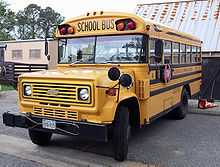Chevrolet/GMC B-Series
| Chevrolet B-Series GMC B-Series | |
|---|---|
 | |
| Overview | |
| Manufacturer | General Motors |
| Production | 1966-2003 |
| Assembly |
Flint, Michigan Toluca, Mexico |
| Body and chassis | |
| Class | Type C (conventional) |
| Layout | 4x2 |
| Body style(s) |
Cowled chassis
|
| Related | GMC TopKick (1992-2003) |
| Powertrain | |
| Engine(s) |
gasoline diesel propane |
The Chevrolet and GMC B-Series was a Class 7 medium duty cowled chassis produced by General Motors for the school bus industry. The B-Series was introduced for the 1966 model year. Production of the B-Series ended in 2003; after 1992, it was exclusively bodied by the Blue Bird Corporation.
Design history
For the vast majority of the B-series' life span, GM's medium duty conventional trucks were based heavily upon the design of their full-sized pickup trucks. While the chassis underneath was of a unique design, the cab and some of the outer bodywork would be derived from the full-size pickup trucks.
The B-series, as a result, closely resembled GM's pickup trucks from the 1950s, up until the mid-1960s. In 1966, GMC introduced its own version of the B-Series, unrelated to Chevrolet.
1966-1970
In 1966, while Chevrolet continued to manufacture the B-Series on a medium duty design based upon their full-sized pickups, GMC moved their B-Series chassis to the H/J series line. This design of truck was the predecessor of the 1978 GMC Brigadier and Chevrolet Bruin. The entire front fascia was fabricated out of steel, and featured butterfly-access panels for servicing. This generation of B-Series offered GMC's gasoline V-8, diesel V-6 (Detroit Diesel), and gasoline inline-6 engines.
GM produced a different B-Series chassis for Chevrolet and GMC until 1971. GMC's medium-duty truck had been reintroduced onto the C-Series line in 1969. However, GM bus chassis production lagged behind truck redesigns, delaying the redesigned GMC to 1971.
1971-1992
When GMC's medium duty line moved back from the H/J line to a modified variant of their full-sized pickup truck in 1969, so too did the B-Series, albeit in 1971. The only external change to the chassis was a different front clip, which also mandated a different dashboard design. Engine options consisted of the 5.7L, 6.0L, and 7.0L gasoline V8. Later, the Detroit Diesel 8.2L V8 was offered, as well as a turbocharged variant. Transmissions were almost always 4 or 5 speed manuals, although the Allison AT545 4-speed automatic transmission was also offered.
While GM replaced its medium duty trucks in 1973, the B-series continued to be based upon the previous generation of medium duty conventionals. In fact, this continued to be the case until 1984, when GM finally updated the B-Series to match; the tilt-forward cowl was added. However, the changes were limited to the outside; the steering column and dashboard were carryover. Little, if any, change occurred to the powertrain options for this generation.
This chassis was used on the Rexhall Airex Motor Home.
1992-2003
In 1992, the GMT 530 chassis was adapted to become the next-generation B-Series. This chassis was introduced in 1989 under the GMC TopKick and Chevrolet Kodiak names.
Both gasoline and diesel engines were offered on this generation of B-Series. A 6.0L (366 cu in) V8 gasoline engine was offered, allowing potential LPG (propane) or CNG conversion. Late in the 1990s, the 366 V8 was retired in favor of a 454-cubic-inch (7.44 L)) V8; GM was the last manufacturer to offer a gasoline engine in a full-size school bus. Caterpillar 3116 turbocharged six-cylinder diesels were offered as well,later models had the Caterpillar 3126 turbocharged six cylinder. Transmissions were either Allison automatics, or a 5 speed manual transmission
When GM replaced the GMT 530 series of medium duty conventionals with the GMT 560 series in 2003, no direct replacement for the B-Series was offered. GM has, however, offered cutaway cabs on their Class 4 and Class 5 models, allowing for body builders to add bus bodies in the same manner (and design) as they would on the full-size van cutaways.
Availability
The B-Series chassis was used by a variety of manufacturers and was popular for the availability of both gasoline and diesel engines. Until 1991, the B-Series was available to all manufacturers. However, in a move that crippled GM's marketshare of the school bus market, GM signed an agreement with Blue Bird Corporation for 1992. Under the terms of the agreement (which lasted 10 years), Blue Bird became the only body manufacturer allowed to build buses on the new B-Series chassis and would also be responsible for all distribution and service. The resulting model was named the CV200, and while the GM B-7 chassis was standard, Navistar International and Ford (and later, Freightliner) chassis were available as options.
- Manufacturers who used the B-Series before 1991

- Blue Bird
- Carpenter Industries, Inc.
- Gillig Bros.
- New Bus Company
- Northern Coach
- Perley A. Thomas Car Works
- Superior Coach Company
- Thomas Built Buses, Inc.
- Ward Body Works
- Wayne Corporation
Powertrain
- Gasoline
| Engine Name | Displacement | Notes |
|---|---|---|
| GM Small-Block V8 | 5.7 liters (350 cubic inches) | |
| GM Big-Block V8s |
|
The 366-cubic inch V8 was a common basis for second-party conversions for alternative fuels (propane and CNG).
After the 7.4L (454 CI) Engine was discontinued GM used the 8.1L Big Block |
- Diesel
| Engine Name | Displacement | Notes |
|---|---|---|
| Detroit Diesel "Fuel Pincher" V8 | 8.2L | |
| Caterpillar 3116 inline-6 | 6.6L | |
| Caterpillar 3126 inline-6 | 7.2L |
See also
| Wikimedia Commons has media related to Chevrolet/GMC B-Series. |
- Chevrolet Kodiak/GMC TopKick - B-Series donor platform (1980-2003)
- Ford B-Series, International Harvester S-Series "Schoolmaster", and International 3800 - competing school bus chassis
- List of buses
References
| ||||||||||||||||||||||||||||||||||||||||